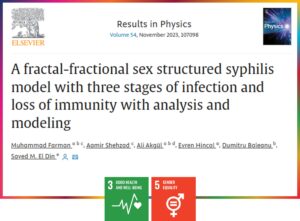
Farman, M., Shehzad, A., Akgül, A., Hincal, E., Baleanu, D., & El Din, S. M. (2023). A fractal-fractional sex structured syphilis model with three stages of infection and loss of immunity with analysis and modelling. Results in Physics, 107098.
A research collaboration from the Mathematical Research Center at Near East University has made significant strides in understanding and managing the spread of syphilis disease, a sexually transmitted infection caused by the bacterium Treponema pallidum. Despite the accessibility of preventive methods, millions continue to be affected in less developed countries, necessitating advanced models to comprehend its transmission dynamics and control.
The study introduces a novel approach—a fractal-fractional model incorporating three infection stages, prevention methods, and immune loss—to comprehensively analyze and predict the spread of syphilis. Utilizing the Mittag-Leffler kernel and fractional-order derivatives, the model underwent rigorous analysis to ensure its reliability, including assessments of positivity, equilibrium points, and threshold quantities.
Through non-linear analysis and numerical simulations, the study demonstrates the profound influence of fractal-fractional derivatives on the disease's dynamics. These derivatives play a pivotal role in understanding the spread and progression of syphilis within populations, potentially aiding in limiting its transmission rates.
The research underscores the model's reliability in examining complex biological systems, showcasing its potential as a tool for understanding various physical and biological mechanisms. Moreover, it highlights the importance of using advanced mathematical techniques like stochastic differential equations and modified fractional derivatives to further enhance the accuracy of the model in representing real-world scenarios.
This research contributes to the global efforts in disease control and prevention. By providing a more precise understanding of syphilis transmission dynamics, the study paves the way for improved strategies in disease management, potentially curbing outbreaks and safeguarding community health. Furthermore, the study suggests that the model's reliability can be further validated by incorporating real-world data, indicating its promise for future research and prevention initiatives. The findings offer a foundational framework for advancing mathematical techniques in studying disease transmission, highlighting the importance of interdisciplinary approaches in addressing global health challenges.
For further details, access the original paper from the publisher's link:
https://www.sciencedirect.com/science/article/pii/S2211379723008914